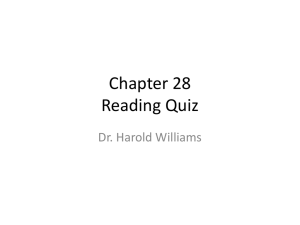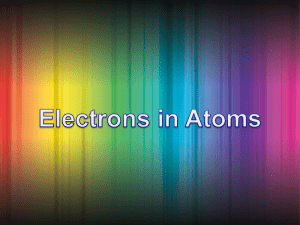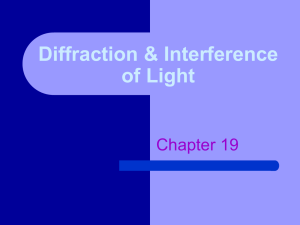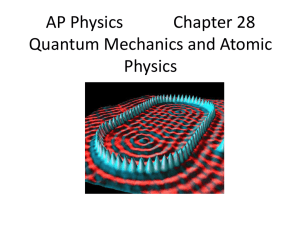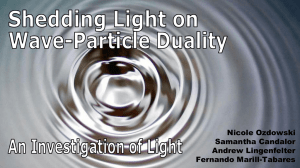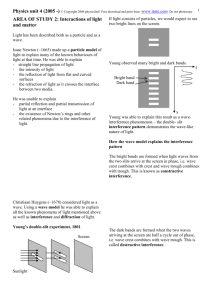2.5 Wave-particle duality
advertisement
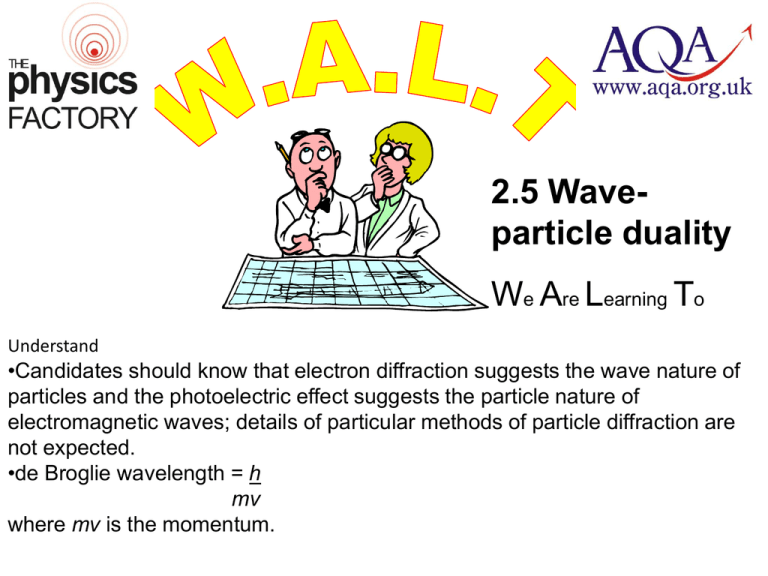
2.5 Waveparticle duality We Are Learning To Understand •Candidates should know that electron diffraction suggests the wave nature of particles and the photoelectric effect suggests the particle nature of electromagnetic waves; details of particular methods of particle diffraction are not expected. •de Broglie wavelength = h mv where mv is the momentum. Starter Newton Vs. Huygens In the 1600s, Christiaan Huygens and Isaac Newton proposed competing theories for light's behavior. Christiaan Huygens (1629 – 1695) Huygens proposed a wave theory of light while Newton's was a "corpuscular" (particle) theory of light. Huygens' theory had some issues in matching observation. Newton's prestige helped lend support to his theory, so for over a century his theory was dominant. Sir Isaac Newton (1643 – 1727) Reflection:- can be explained by treating light as a wave or a particle Interference: - this can be explained by the wave theory of light (treating light as a wave) Refraction of light:can be explained by treating light as wave or particle Interference of light:- can only be explained by treating light as a wave TOMAS YOUNG 1805 INTERFERENCE EXPERIMENT constructive interference destructive interference Diffraction:- can be only explained by treating light as a wave Main Demonstrate diffraction of light Light can be diffracted circular aperture light Light must be a wave Photoelectric Effect:- can only be explained if treat light as a particle (photon) Main Activity Particles Behavior of Electrons Particle behavior cathode anode Electrons travel in a straight line when they meet an obstacle they cast a sharp shadow, no diffraction is observed as would be with waves. Also accelerated electrons can be deflected by magnetic fields and electric fields, waves are not affected by these fields. So electrons are particles, right? Wave Behaviour of electrons Test: Can electrons be diffracted? vacuum heater graphite target YES, ELECTRONS DO HAVE A WAVE NATURE Wave behavior of electrons The particle theory predicts we should observe a single blurred spot where the electrons hit the screen. In fact we see a interference pattern which can only be explained by the wave theory. The regular atoms in the graphite diffract the electrons which interfere to produce regions of maximum and minimum intensity TOMAS YOUNG 1805 INTERFERENCE EXPERIMENT constructive interference destructive interference Plenary Duality Light behaves like water waves in a ripple tank min max min max min max Light must be a wave min Light can be diffracted circular aperture light Light must be a wave Photoelectric Emission! LIGHT MUST BE A PARTICLE! Photon of Light potassium metal PRE 1900 CLASSICAL THEORY 1900 PLANCK’S QUANTUM THEORY ENERGY IS CONTINUOUS AT THE ATOMIC LEVEL VARIABLE ENERGY IS QUANTISED, IT CANNOT HAVE ANY VALUE EINSTEIN (1905): Light comes in packets of energy. ENERGY OF A PHOTON is but c = f λ E hc combining E hc and hc mc 2 E mc i.e. the wavelength of a photon is Planck’s constant divided by its momentum, p . 2 h mc h p Electrons cast sharp shadows and are affected by magnetic and electric fields, unlike wave Electrons must be Particles Electrons must be Wave-like Electron diffraction can only be explained if electrons behave like waves 1923 : Louis de Broglie : “If a photon behaves as particle with mass, then a particle should have an associated wavelength given by h h mv p where v is the particle’s velocity Summary • The wave-like nature of light is observed when diffraction takes place • The particle-like nature of light is observed in the photoelectric effect • The particle-like nature of electrons is observed by magnetic and electric deflection • The wave-like nature of electrons is observed in electron diffraction • Particles have a wavelength given by: What’s your wavelength? According to De Broglie, you have a wavelength! What do you notice about it? What are the implications?
